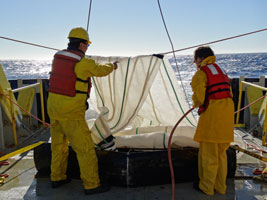 |
The Matsuda-Oozeki-Hu trawl (MOHT) is a fixed-frame trawl with a 5.5 m2 mouth opening with a cambered V-type depressor that can be towed at speeds up to 4.5 knots. It is designed to capture a variety of organisms including krill, late larval and juvenile fishes, and micronekton. The Oozeki data are used to groundtruth the EK-60 acoustic data as well as collect samples of juvenile fishes for the study of sardine recruitment processes.
 Samples collected with the Matsuda-Oozeki-Hu trawl (MOHT) are used to ground truth the multi-frequency acoustics. While the use of acoustics provides a real-time high resolution technique to study aquatic organisms, it is an indirect technique and the scatterers present in the water column need to be identified. Because of this, net samples need to be collected to ground truth the acoustic data. The MOHT is a net with a 5 m2 mouth area and a cambered V-type depressor designed to sample juvenile fishes. It can be trawled at speeds of up to 4.5 knots under variable weather conditions. Three types of oblique tows are conducted:
Samples collected with the Matsuda-Oozeki-Hu trawl (MOHT) are used to ground truth the multi-frequency acoustics. While the use of acoustics provides a real-time high resolution technique to study aquatic organisms, it is an indirect technique and the scatterers present in the water column need to be identified. Because of this, net samples need to be collected to ground truth the acoustic data. The MOHT is a net with a 5 m2 mouth area and a cambered V-type depressor designed to sample juvenile fishes. It can be trawled at speeds of up to 4.5 knots under variable weather conditions. Three types of oblique tows are conducted:
- Shallow tows: the net samples to 150 m depth. This is carried out at night to sample migratory mesopelagic organisms as well as epipelagic organisms.
- Deep tows: the net samples to 400-600 m depth and is carried out during the day to sample mesopelagic organisms (migrating and non migrating).
- Targeted tows: sampling is carried out targeting an acoustic feature of interest in the echogram. The net will sample to the depth where the acoustic feature (school or layer) is located.
 |
Additional Information
|
